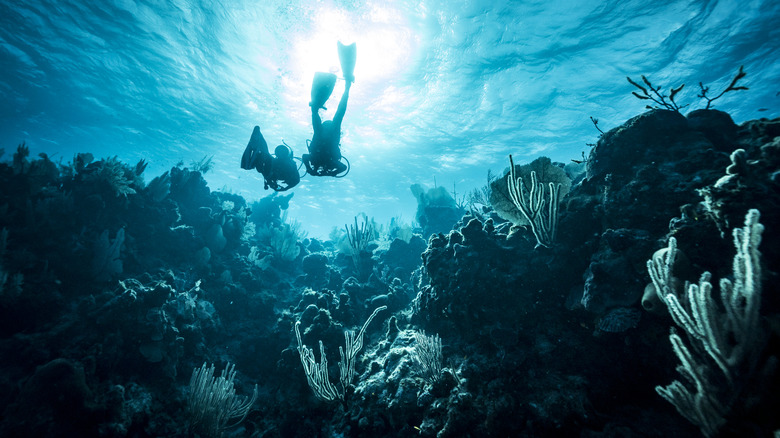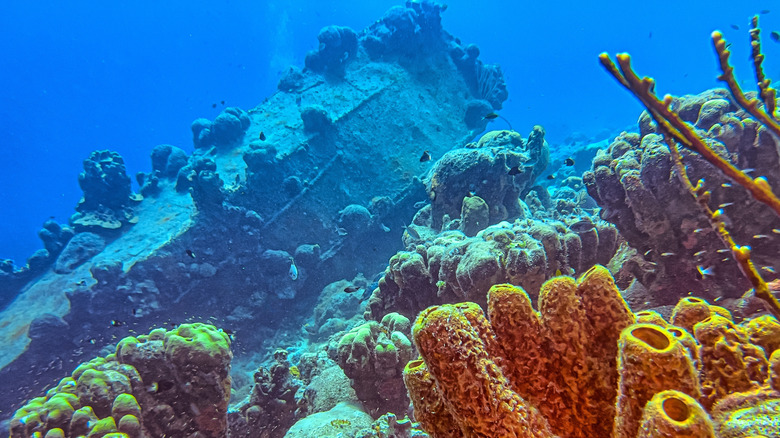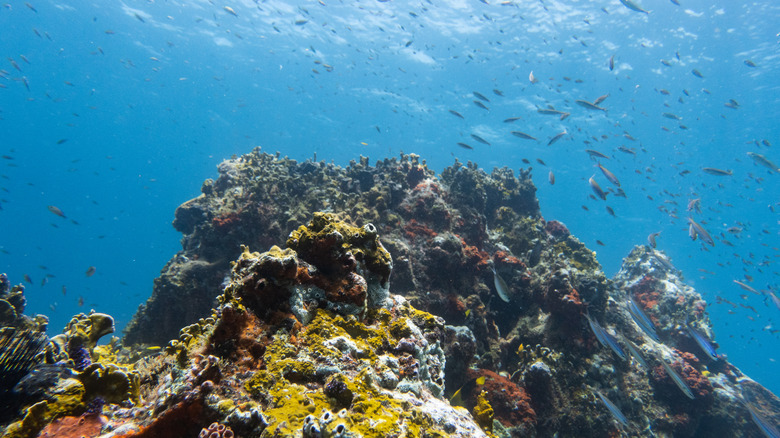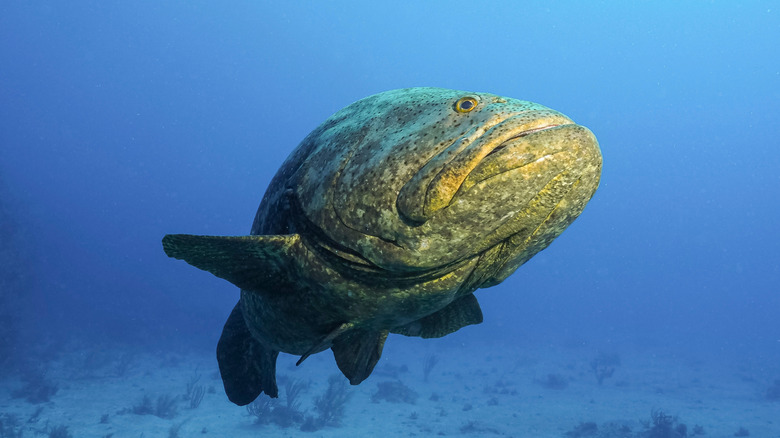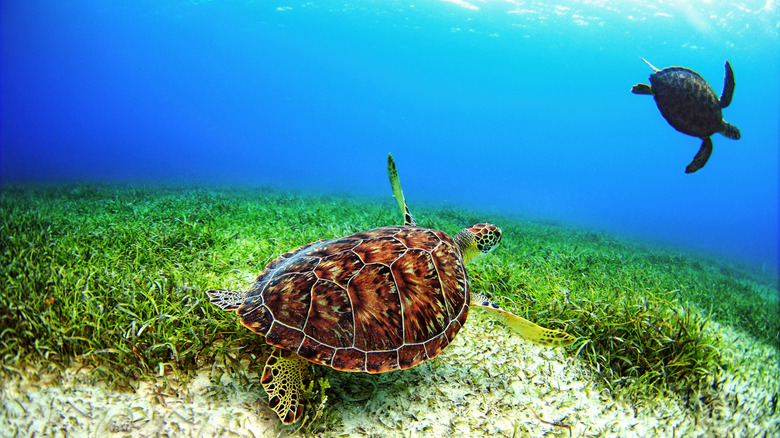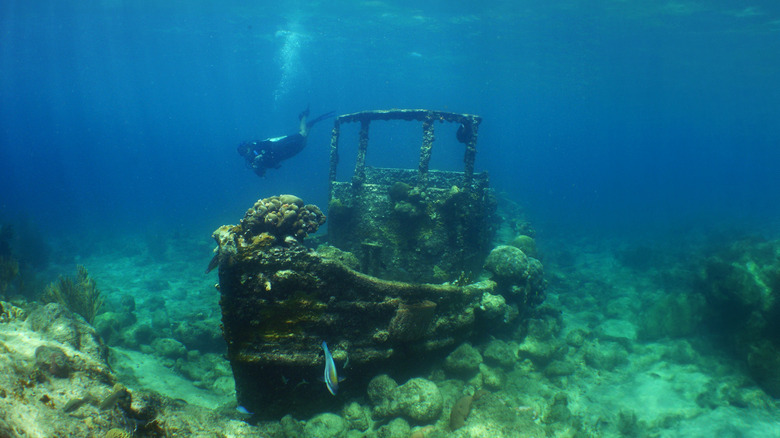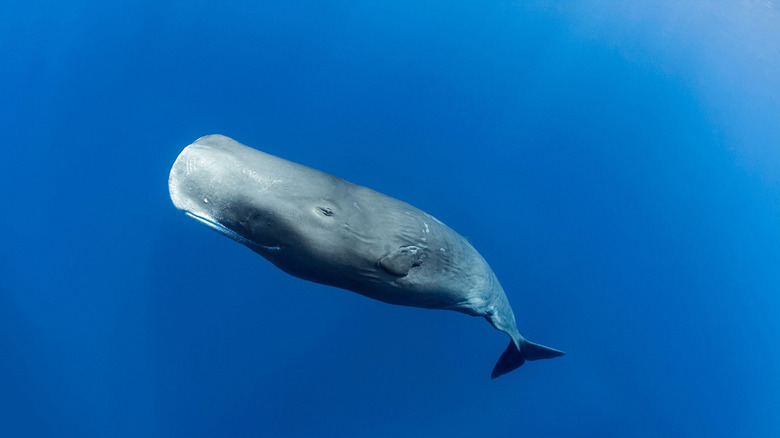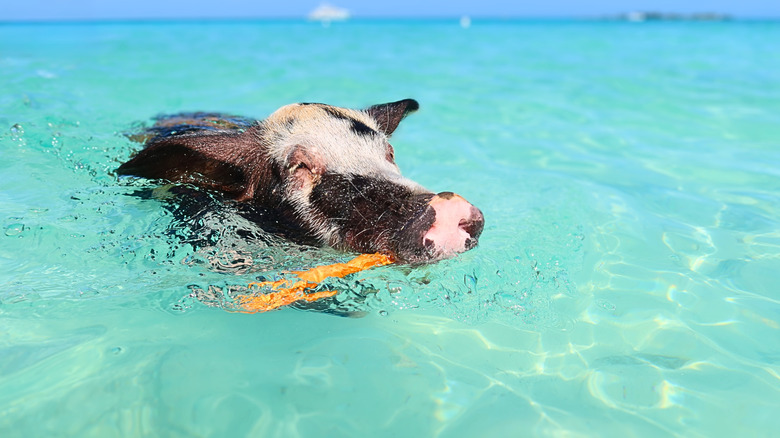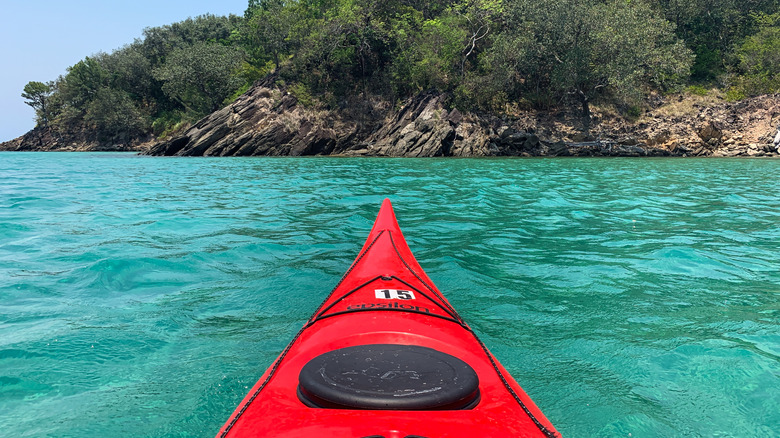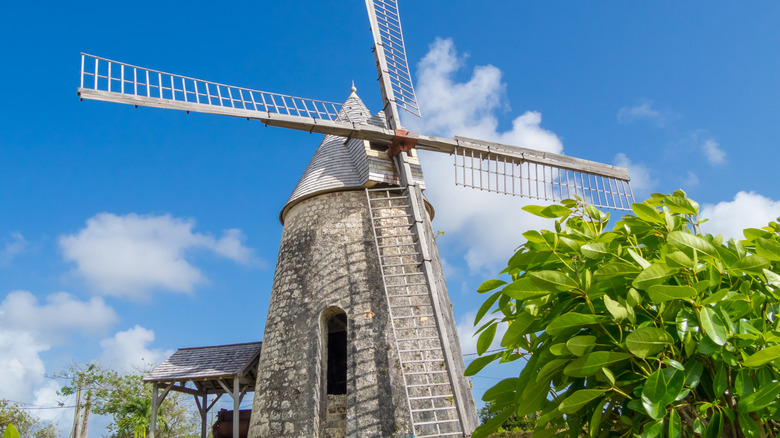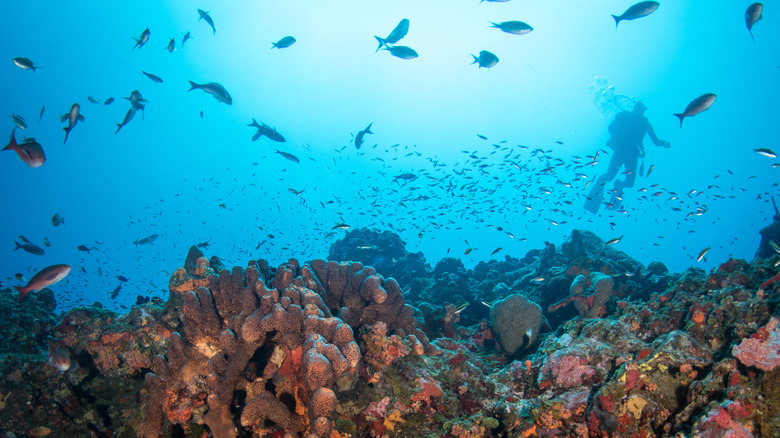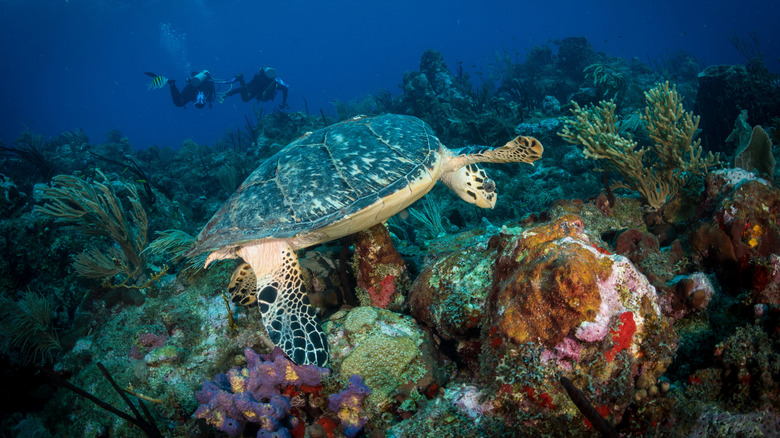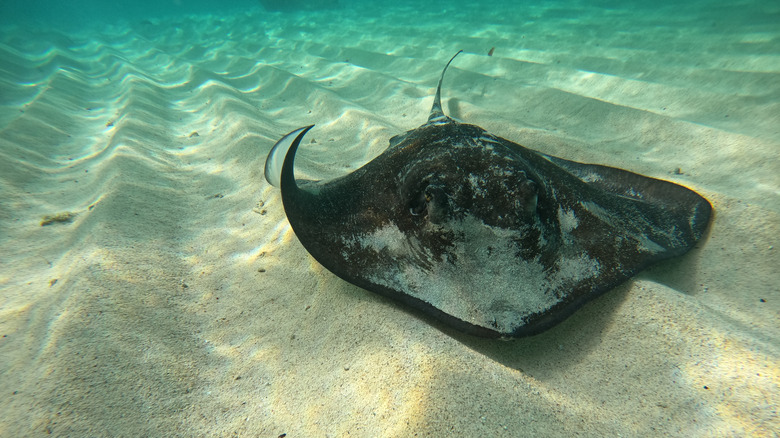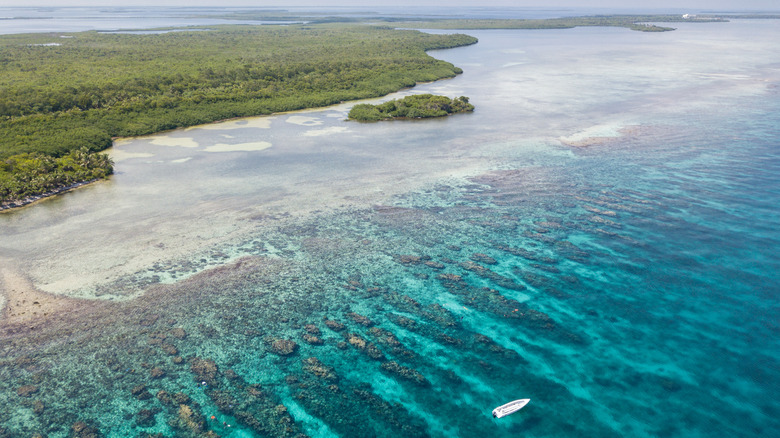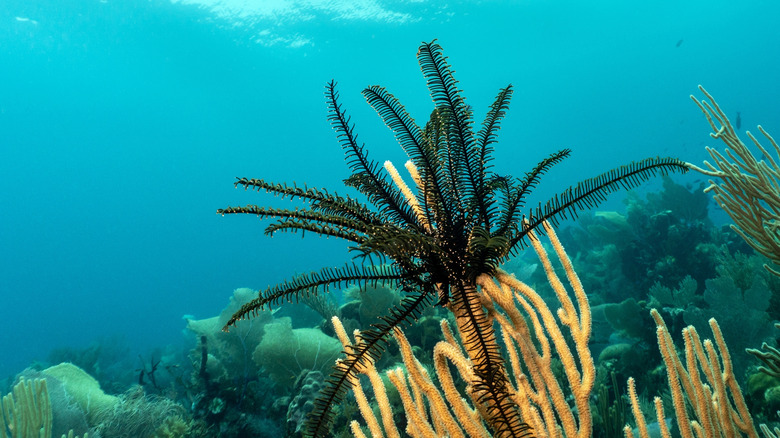Little-Known Caribbean Islands For Marine Life Lovers
For many travelers, the Caribbean is the very definition of paradise. The destination has, after all, successfully portrayed itself as an easy, breezy vacation option. That is because the image of the Caribbean is invariably always a place that's sunny, where languid palm trees flutter in the gentle coastal breeze, and where sandy beaches lead to clear, calm, turquoise seas. For fans of swimming in the sea, or lounging on delicious beaches, there are few better places so close to the U.S.
A few islands in the Caribbean are high on the radar of international travelers, locations that have fun water parks to check out, or excellent all-inclusive resorts for adults only. But for every familiar island rich in marine life, like Jamaica, St. Thomas, or Barbados, there are many more that exist in the background. For divers and snorkelers — or even simple fans of aquatic life — looking for a lesser-known gem with rich, healthy marine treasures, the choices are impressive.
Bonaire
Along with Aruba and Curaçao, Bonaire is one of the "ABC islands," three isles close to Venezuela that are politically linked to the Netherlands. It's a small island, and the main hub of activity is the waterfront town of Kralendijk. Despite its Lilliputian size, it punches way above its weight for marine riches, with more than 90 dive sites around its shores. Creatures whoosh and wiggle in numbers because Bonaire has vibrant, healthy coral reefs, clearly visible thanks to the clear waters around them. Among the sightings that paddlers, snorkelers, and divers in the water will see are plenty of colorful coral frequented by schools of fish, and a selection of turtles.
A number of sites attract visitors. Hilma Hooker was a 185-foot freight ship that was sunk in the waters in 1984 as a way to generate an artificial reef. Divers that wind their way around the structure will be able to see eels, tarpons, and much more. Right by Kralendijk, the Something Special dive site teems with reef fish, grouper, barracuda, and even the elusive frogfish. Elsewhere on this wildly underrated tropical paradise, travelers will find a national park with flamingos, vast tracts of untamed wilderness, and bright pastel buildings that reflect Dutch colonial architecture.
Carriacou
The name of this island, pronounced "karry-a-cou," translates to Isle of Reefs, which gives a hint as to what snorkelers and divers can expect in the water. Carriacou is one of the islands of the Caribbean nation of Grenada and is a curving destination shaped a little like a leaping dog. Visitors can get to Carriacou from Grenada's main isle by plane or ferry, and what they will find is a hilly, peaceful refuge with a few small villages and a sweeping, curling coastline.
A number of events occur on the island throughout the year, from the Maroon Festival to the Carriacou Regatta. Boat building is also a local mainstay on this easy-going destination. Under the waters around Carriacou, however, the action really heats up. Some of the most vivid marine treasures can be found around Mabouya Island, just off Carriacou's west coast. Mabouya Garden is a site on the north of Mabouya, where a reef wall hosts eels, sharks, rays, and plenty of coral. Close by, Tugboat Boris is a 100-foot tugboat that sits on the seafloor. Nowadays, it is home to angelfish, barracuda, and lionfish that live among the propellers.
Cuba
A nation that sits less than 100 miles from Florida, Cuba is by some stretch the largest nation and island in the Caribbean. It might not be completely unknown to Americans, but getting there, for U.S. citizens, requires a bit more planning than for other Caribbean islands. The island has long strands of beach along its seemingly never-ending coastline and beyond the shore lie waters filled with marine life. One of the best sites for exploring the sea is a national marine park called Jardines de la Reina, or the Queen's Gardens. This tranche is mandated as protected by the government, so the coral and fish are able to prosper without human interference. Jardines de la Reina sits some distance south of Cuba, and its remoteness only adds to its fecundity. In it, you will find small islands ringed by mangroves, and coral reefs sitting offshore replete with groupers, sharks, and turtles.
On the island of Cuba, Playa Girón has a couple of prime spots for snorkeling. Caleta Buena has clear turquoise water and since it's protected by a slender finger of rock in front, the water is so still that it feels like a pool. Expect to see tangs and moray eels. Close by, Punta Perdiz presents bathers with a healthy coral reef. Other good options, where the sea is a little more lively, are the coastal getaways of Playa Santa Lucia and Guardalavaca.
Culebra
Shaped a bit like a fish with a broad tail, Culebra sits roughly halfway between St. Thomas to the east, and the main island of Puerto Rico to the west. The island is known for its wilderness, with about one-quarter of Culebra and its smaller islets falling under the auspices of the Culebra National Wildlife Refuge. This is a secret island home to some of the Caribbean's prettiest beaches, but it also is home to some rich, and varied marine life.
That said, you don't even have to get in the water in Culebra to see turtles — they frequently appear on the beach. Travelers that do end up in the sea, however, will also spy turtles, as well as manatees that nibble on seagrass, and perhaps manta rays as they swoosh through the water. There are also coral reefs all around Culebra, and marine creatures that frequent them include parrotfish, angelfish, butterflyfish, and seahorses.
Curaçao
The island with links to the Netherlands is, figuratively, a stone's throw away from South America. The area between Curaçao's south and west coasts, and the continent to the south, is where to find the premier dive sites of the island. Many of the dives are doable directly from the shore, and this is a large part of the appeal of visiting Curaçao, a place where both hard and soft coral thrive.
Around Westpunt, on the island's southwest, beaches like Playa Kalki let divers and snorkelers head to a lively site right from the shore. Exploring the waters there, swimmers will see damselfish, parrotfish, and more. Mushroom Forest is named for the mushroom-shaped coral that attracts lobsters and moray eels. Tourists can also dive among shipwrecks. One of the most renowned sunken ships is "MV Superior Producer," situated about 100 feet underwater, and peppered with sponges and coral.
Dominica
This small nation, not to be confused with the Dominican Republic, isn't widely known for its vast range of sandy beaches. Many beaches on the island are rocky, but if you head for the seas, you will find giant creatures like whales navigating the depths. This is an excellent place to explore the marine domain since many dives take place in shallow waters — this also ensures good snorkeling. Better yet, the water temperature hovers around 80 degrees Fahrenheit year-round.
Some of the highlights underwater are the wildly hued sea sponges, some of them grand presences that dominate the sea. There are also reefs, regularly visited by French grunts, yellowtail snappers, and creole wrasse, a species with an enchanting purple color. At the site of Danglebens Pinnacles, rock formations rise underwater like a submarine mountain range. Elsewhere in Dominica, visitors will find a hiking trail that runs for more than 100 miles and a large boiling lake.
Eleuthera
The long, skinny, kinked island in the Bahamas has so many marine animals to spot. On a map, Eleuthera looks akin to a necklace laid flat in a sea of blue. It lies a short distance east of Nassau, about 60 miles away. It's a place of scenic beauty, with locations like the small seafront pools at Queen's Bath, a fun spot to spend a day. In the water, the aquatic riches will likely strike awe in visitors. Travelers can expect to see the delicate, red-colored northern seahorse, or the sand-hued longsnout seahorse.
The red hind, with its spotted skin, appears like a leopard in the water. One of the most exciting sights though is the queen triggerfish. With its broad, flat body, delicate fins, and skin that morphs from yellow to purple to white, the fish is a thrilling sight to see as it glides and wriggles underwater. Boaters will also enjoy trips to Eleuthera, as there are many small cays along its coast make them fine spots to indulge in some island-hopping.
Exumas Cays
East of Grand Bahama, this cluster of islands features a vast park with vibrant sea life. Officially known as the Exuma Cays Land and Sea Park, it extends across more than 100,000 acres. Some of it spreads across the Atlantic Ocean, some along the small isles in the archipelago. It is one of the most popular snorkeling spots in the Bahamas. The park was created in the 1950s by the Bahamas National Trust, and starting in 1986, the sea around the Exuma Cays (even outside the park's boundaries) was established as an area where fishing was prohibited.
This has proven to be a blessing for the proliferation of marine life, with spiny lobster, queen conch, and more, flourishing as a result. One of the best places to base yourself is Staniel Cay. From there, it's an easy hop to swim with sharks at Compass Cay, and visit the swimming pigs on Pig Beach — yes, that really is a thing.
Guanaja
A small island in Honduras that is shaped a little like a diving seabird, Guanaja allows travelers to see lobsters and octopus. A reef just offshore is part of a reserve, so visitors can enjoy the sea, and its rich life, without fear of heavy commercial fishing traffic. Guanaja is a quiet place, with a population of only 10,000 residents, most of whom live on the small isle east of Guanaja airport called Bonacca. Guanaja has more than 40 dive sites, and many places for an enjoyable snorkel excursion.
What visitors who leap into the sea will be able to witness are underwater pinnacles, caves, canyons, and tunnels formed by lava (this region has volcanic origins). One of the premier dive sites is Jado Trader, a shipwreck that has corals growing on it. In terms of aquatic treasures, you can expect to encounter black coral, which isn't commonplace in many places around the world, bright sponges, sharks, rays, moray eels, and giant crabs.
Little Corn Island
This is one of two Corn islands (the other is called Big Corn Island, no surprises there) that are part of Nicaragua, and as the name suggests, it's the smaller of the duo. Despite its size, Little Corn Island is a rich spot for sea life. There are more than 20 sites for diving around the island, with a reef playing host to many marine creatures. You'll be able to see eels, starfish, and rays, and for fans of larger creatures, dolphins and sharks are known to roam the waters.
Most dive sites aren't particularly deep, so for divers that are newly certified, this is a great spot to get their feet wet, literally. The island, a lesser-known Caribbean gem, is an easy-going hideaway to spend a few days. There are a handful of places to stay, eat, and have a drink. What visitors will find are fine beaches dotted all over the island, perfect places for lounging when you want a break from the sea exploration.
Marie-Galante
This island shaped like a circle is a French territory, and is situated between Dominica and Guadeloupe. The isle is quite flat, and has carved out a name for itself for the rums produced there. Marie-Galante has fields of sugar cane all over its land, and there are many mills that process the sweet harvest. The island has also managed to evade the ravenous grip of commercial tourism, which has helped it retain a sense of quiet island charm. For visitors that make the effort to come to Marie-Galante, the rewards include the opportunity to see some lively marine life.
The undersea terrain varies depending on which side of the island a traveler visits. The leeward side (the west of Marie-Galante, sheltered from the winds), tends to be more wild, and features sea caves and sudden, sharp drops in the sea floor. This is where to find coral and sponges, and creatures that include stingrays, turtles, and batfish. For travelers that prefer to experience the water from a boat, a trip to Marie-Galante during February and March will bring them close to humpback whales as they migrate south.
Saba
It was in 1987 that Saba established a marine park. The Saba National Marine Park is comprehensive in its coverage, with a zone that circles the entire island and extends outwards to a depth of 60 feet below sea level. The guidelines of the park ensure strict limits on fishing and anchoring of boats. This has proved a boon to sea life, and of particular note are the big schools of Nassau grouper that are regularly spotted in the seas around Saba.
In addition, travelers will be able to see barracuda, parrotfish, chromis, tangs, and wahoo. There are numerous species of sharks that ply the waters, as well as turtles, eels, seahorses, rays, and lobster. Coral is also represented in generous amounts, both on reefs and colonies, and also on volcanic rocks in the sea. Saba itself feels a little remote. A small round island, it is located east of the U.S. Virgin Islands, and south of Anguilla.
Sint Eustatius
Another blip of an island, Sint Eustatius sits between Saba and St. Kitts. The island is part of the Dutch Caribbean, and getting there requires catching a flight from St. Kitts, Anguilla, or spectacular St. Maarten. Alternatively, there are ferries from nearby islands like Saba and St. Kitts. Once on Statia, as it's often called, travelers will experience rainforests and even dry forests, places where the orange-faced ameiva lizard and the red-bellied racer snake endure. There are also lots of birds on Sint Eustatius, with hummingbirds, doves, and much more flitting around the air. Offshore, reefs enliven the seas, and marine life teems around them.
Like Saba, the island has a protected marine sanctuary. The St. Eustatius National Marine Park surrounds the island and extends out to waters more than 60 feet deep. Two sections in the park are earmarked as reserves, where fishing and dropping anchor are prohibited. Plunge into the clear shallows, or depths, around Statia and you can expect to see snappers, barracudas, stingrays, and giant lobsters. You might also be able to see the largest fish around, the mighty whale shark.
St. John
This U.S. Virgin Island is home to a couple of the most gorgeous campgrounds in the Caribbean. If that weren't reason enough to visit this island with a wildly craggy, indented shoreline, then the marine life is another persuasive reason. The riches in the waters around St. John are too abundant to fully describe in a few sentences, but some highlights are worth pointing out. The slightly alien-looking balloonfish, which some travelers might call pufferfish, hover among colonies of coral.
Angelfish have slender bodies that allow them to slide between coral to feed off algae, but even then, snorkelers and divers will be able to see their bright purples and yellows. Chromis, small fish with an electric-blue shimmer, often congregate in groups, and contrast strongly with the sandy coral. Moray eels sometimes poke their heads out from rocks, while dolphins are less shy, cavorting in the clear waters. Other prized sightings include the stingray, octopus, spiny lobster, and the delicate, ever waving sea fan.
Turneffe Atoll
To get to Turneffe Atoll, a scattering of islands east of Belize's mainland, you need to hop on a boat for a transfer that takes more than an hour. Once there, you'll find warm water that's improbably clear, and seas that brim with marine life large and small. One of the main draws to Turneffe Atoll for divers and snorkelers is the presence of giant tube sponges, vibrant yellow, and growing up to four feet in height. The snorkeling is spellbinding, allowing visitors who aren't certified divers to enjoy the spectacle.
A reef is found all around, with some coral visible just a foot below the surface. For snorkelers, all they need to do is put on a mask and snorkel, slide on some fins, and slip into the sea. Pretty soon, before their eyes, there will be an ever-changing parade of rays, lobsters, dolphins, and scores of different fish. And if they are really lucky, snorkelers might even catch sight of a manatee.
Utila
In Honduras' Bay Islands, Roatán is perhaps the most famous for its underwater riches and well-established tourism infrastructure. But Utila, which lies southwest of its more famous sibling, also promises a rewarding underwater experience. Within the waters of tiny Utila, tourists can glide along the healthy Mesoamerican Reef and as many as 500 species of fish that live there. Second in size only to Australia's Great Barrier Reef, the Mesoamerican Reef is a force of nature, extending from Mexico's Yucatan Peninsula down to the Bay Islands of Guanaja, Roatán, and Utila.
In addition to fish, you can expect to see coral and plenty of mollusks. What else is in store for travelers who make their way down to this part of the Caribbean? Within the clear sea, you can look forward to hawksbill turtles that rise and fall in the water, nurse sharks that wind in the shallows, eagle rays that swoop effortlessly by the sea bed, and sea horses whose tiny size and delicate shape almost defy belief.
